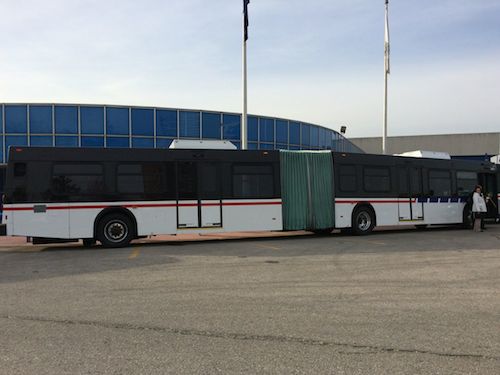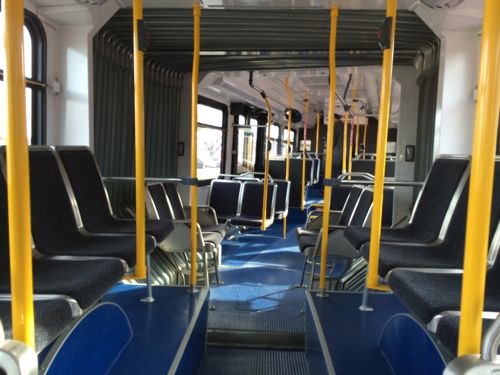Poll: Metro’s 60ft articulated buses are completely rebuilt 2004 New Flyer models from Ottawa, costing $430k/ea vs $825k/ea new, reaction?
Friday Metro showed off the first of (15) 60-foot articulated buses that’ll be here by the end of summer, 5 will go into service on the busy #70 (Grand) MetroBus route on June 9th. St. Louis isn’t the only city that bought some of Ottawa’s 226 old articulated bus fleet. From March 2012:
Last week, Winnipeg Transit announced it wants to spend $1.1 million to purchase articulated buses at a discounted rate from New Flyer Industries, after Ottawa traded them in for new buses. The buses will cost $53,000 each, instead of the $625,000 they would cost brand-new.
In total, it will cost Winnipeg $2.2 million to buy and fix up the buses. (City committee in favour of buying articulated buses)
For years Metro has purchased new buses from Califiornia-based Gillig, but they still don’t offer an articulated bus. New Flyer, out of Winnipeg, Manitoba, Canada, has been offering articulated buses for years.


For more information, see Metro’s articulated bus fact sheet (PDF). These new buses are the subject for the poll this week, I’d like to get your thoughts. I’ve provided a range of answers, plus I’ve also set the poll so you can enter your own if you don’t like the ones provided. The poll is in the right sidebar. Results and my views will be posted on Wednesday April 2nd.
— Steve Patterson
We have to find innovative ways to move forward while being sustainable and creative with resources at the same time. I’m all for it! Just because something isn’t brand new doesn’t make it functionally inadequate.
One, as with every other transit vehicle, it’s a tool to move people. If it provides more capacity on a busy route, at an affordable cost, it’s a great choice. If it’s like the Loop Trolley, where we’re spending $40+ million to put in 2.2 miles of track and to buy a whole five refurbished vehicles, I’m not so sure. We could buy nearly 100 refurbished buses, like these (and move way more people) for the same money we’re spending (wasting?) on Joe Edwards’ latest tourist attraction.
Two, your description of it being “basically a 30 ft bus with a 30 ft trailer” isn’t very accurate. It is a bus that truly bends (articulates) in the the middle, much like our light rail vehicles. The engine is in back, the driver is in front, and everything in between is connected.
Three, the real question on whether or not this turns out to be a good deal is with stuff we can’t see. Most transit coaches are designed to have a 14-15 year lifespan in daily service. A 10-year-old vehicle from a northern city where road salt is heavily used could have serious issues with frame corrosion. And the real question is just what is replaced versus just “tuned up” when the vehicle is “refurbished”? Engine? Transmission? Brakes? Air conditioning? Steering components? Wheels? Tires? Seats? Electronics? Wheelchair lifts?
Finally, there are multiple vendors for transit vehicles, many with just a limited range of specialized models. Since pretty much every vehicle is custom ordered and built to meet the specific requirements of each property, the specific brand name is less important than the individual components that go into the vehicle and the company’s past track record and its financial stability moving forward – warranties are only as good as the companies behind them. GM, MAN, Neoplan, Flxible and Crown are all big names in the transit coach industry from the past. For good coverage of what’s currently available, check out http://www.metro-magazine.com/page/bus-showcase.aspx
Poll is still parking related, for me anyway.
Used sounds fine to me. I’m sure Metro has run the numbers/requirements and thinks this is the best way to reach the goals they have. My only hesitation would be that they are from Parliament Hill. Western Canadians go to great lengths to avoid buying used cars from Eastern Canada as “salt bunnies” tend to have all sorts of corrosion related issues/problems. The salt literally gets into the air and eats everything.
Sorry about that, got busy with breakfast and filing taxes! I’ve updated the poll code now.
One of the big reasons Neoplan pulled out of the US market was problems with their frames rusting and even breaking: http://old.post-gazette.com/regionstate/20001023busesreg1.asp
If this is added service, then it will also provide more frequent service. More frequent service
with regular buses would be preferable, but presumably would increase labor costs more
Not added service, Metro operates 12 40ft buses on Grand currently, they’ll use 12 60ft articulated buses instead. Yes, more frequent buses would add to operating costs.
Cheaper? Check. I’ll assume rebuilt engine/trans, and other assorted running gear and brakes? Check. Refurbished interior? Check. Wiring? Check. Controls? Check. Larger capacity? Check. The Federal gubmint gave us some money to pay for them? Double ****ing check.
I will naturally assume that any structural issues with regards to running in a far-north climate with snow-melt chemicals have been addressed, though I expect that the alloys used in the frame and body panels have an increased resistance to corrosion. Matter of fact, I’ll assume aluminum body panels, which are not only more resistant to corrosion, but obviously offer weight savings. Not to mention that it’s highly doubtful that Metro didn’t inspect these in situ as they were being refurbished. At the very least, I’m certain that Metro has a checklist at least a couple of thousand points long to run through before these even go into service. As I’ve never heard anything remotely resembling a discouraging word about Metro maintenance, I think the Grand route riders can rest easy and that these vehicles will be quite road-worthy.
Sounds good. Can’t wait to see them run.
I talked with a Metro maintenance official and a person from the firm that’s rebuilding these. These are basically equipped like a brand new 40ft Gillig bus — engine, transmission, suspension, brakes, wiring, etc. all in the shell of a former 60ft New Flyer. The DOT has rated it for use for 6 more years but with their maintenance plan to get at least 10. They run new Gillig’s for 15.
T’ain’t a bad deal at all.
So the plan is to get 6-10 years use out of the used vehicles versus 16-20 years out of new vehicles – sounds like a wash, financially, since these vehicles will need to be replaced much sooner than new ones . . . . “Pay me now or pay me later!”
Metro gets 15 years out of new vehicles whereas others get maybe half that.
You have no idea what you’re talking about! Yes, Metro gets 15, or more, years out of its new, full-size, transit coaches, but so does almost every other property in the country! See, there’s this thing called the Federal Procurement Process that needs to be followed before any federal funding will be forthcoming: http://www.fta.dot.gov/grants/12831_6037.html . . And part of that process is selecting from vehicles that have passed the rigorous testing at the Altoona Testing Facility: http://www.altoonabustest.com/ . . It doesn’t matter if it’s Metro, CTA, RTD, MTA or SunTrans, every property is in competition for limited federal funding, and the feds are not going to give you money to replace 6-year-old vehicles when other properties need to replace 12, 14 or 16-year-old fleets: http://www.fta.dot.gov/13057_6087.html . . .
I’ll repeat, spending half as much, now, per vehicle, to get more vehicles on the street, more quickly, is probably a smart decision. But don’t expect any miracles when it comes to longevity. Transit coaches wear out for a variety of predictable reasons, including metal fatigue, corrosion, lack of replacement parts, advances in technology and less predictability in daily operation. Failures out on the street mean passengers are left at the curb and emergency repairs cost more than scheduled maintenance. So whether we spend $43M/year in capital costs ($430M/10) for refurbished vehicles or $52M/year ($825M/16) for new vehicles, it boils down primarily to the difference in maintenance costs – with a new vehicle, the maintenance costs are lower in the earlier years, with costs increasing every year it’s in daily use.
It would be interesting to learn exactly why Ottawa decided to “trade in” 10-year old buses, which I was able to find here: http://www.newflyer.com/index/2010_04_28_ottawa_buy_order . . They did so to gain “an estimated 26% reduction in fuel consumption and an estimated 15% reduction in maintenance costs . . . . Further, the upgraded propulsion system saves approximately 1.98M Kgs of NOx and approximately 51.4K Kgs of particulate over the next nine years. This is an estimated reduction to the environmental footprint left by the buses of over 90%.” Unless we’re investing in the same technology as these vehicles are remanufactured, we’re just going to be spending good money on less-than-state-of-the-art equipment. Still, in the short term, getting more service on Grand is probably worth the investment – we just can’t “rest on our laurels” and in any way assume that we’ve “solved the problem” . . . .
I talked with Metro last week about it, here’s an example:
“In Metro’s case, the older fleet had an engine average life just over 100,000 miles. At its peak, the Engine Department rebuilt 120 engines annually to keep the fleet on the street. Significant manpower and parts resources went into that effort. Today, the engine life has grown from 100,000 miles to a combined average of just over 450,000 miles With AssetWorks FleetFocusTM, the maintenance team is confident that they will in the future retire busses with its original engine based on improved reporting, tracking and alerts. Today, maintenance management budgets only nine engine rebuilds annually for extraordinary circumstances.” — from “Case Study Metro Transit System St. Louis, Missouri Second to None – How the Metro Transit system of St. Louis leveraged AssetWorks FleetFocusTM and became the Federal Transit Administration’s model for best practices in the U.S. transit industry” http://www.assetworks.com/pdf/case_studies/AW_Metro_St_Louis_CaseStudy.pdf